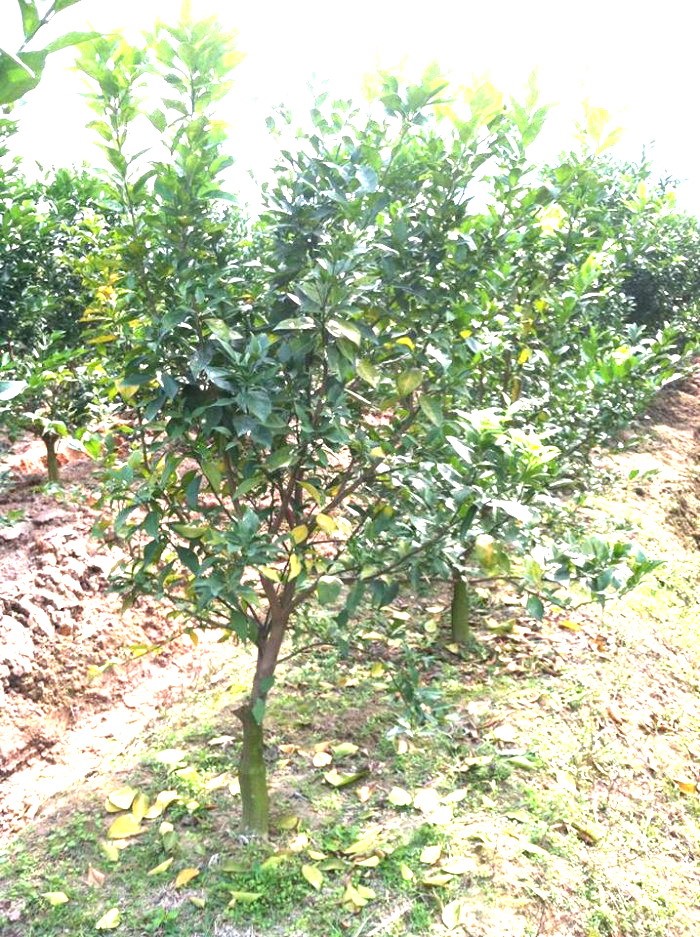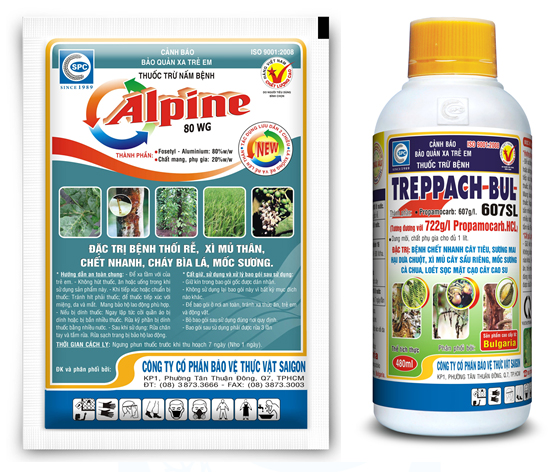|
Yellow Leaf, Citrus Root Rot Disease
07/09/2021
Ph.D. Nguyen Minh Tuyen In recent years, orange tree is one of the crops with high economic value in Vietnam, so orange area and investment are constantly increasing. However, the expansion of acreage and increased investment are factors that contribute to the development of many pests. One of the dangerous diseases with orange trees today is yellow leaf root rot. This is a disease that is causing confusion for citrus growing areas, especially in the Mekong Delta, due to the high cost of prevention, but the orchards are still heavily damaged. Therefore, finding out the scientific and technical achievements to apply is one of the key factors to manage this disease. * Pathogen: Caused by soil-borne fungi such as Fusarium, Phytophthora, Pythium, Rhizoctonia etc ... Caused. However, the primary cause is nematodes, insects, etc. Damage to the roots, creating a gateway for pathogenic fungi to invade and cause harm, especially Fusarium sp., Phytophthora sp. * Symptoms and harms: When the plant gets infected, the whole leaves are yellowed, the leaves are yellowed in both blades and veins, the old leaves are yellow first, then then the medium leaves and young ones. The yellow leaves are prone to fall, usually from bottom to top. The leaves of the whole plant are yellow or sometimes only some branches are yellow. Usually there are branches with yellow leaves above, then correspondingly below the soil in the same direction there have been rotten roots.. Depending on the extent of damage to the roots, the leaves will turn yellow or temporarily wilt respectively. When a lot of the hairy roots (white roots) are damaged, the plant will have small and yellow leaves due to the inability to absorb nutrients. When most of the hairy roots are damaged at the same time, the plant will experience temporary wilting, even if the soil moisture is high. If left untreated, the rot phenomenon will spread to the large roots, weakening the plant and even dying. The fruit of the diseased tree is usually pale in color and not fresh, the pulp is spongy and dry, pale and has a poor taste. * Preventive measures: - High planting: Dig a hole to fertilize, then fill it with soil to plant, make sure the tree stump is higher than the garden surface later, so that there is no stagnant water at the base after rain or watering. - Water system: Need an irrigation and drainage system to manage water well. The stump must be raised to ensure it is always dry. Do not water directly at the base of the tree, but only around the canopy. It is necessary to drain the water thoroughly during the rainy season, to prevent water from overflowing from one garden to another. In the dry season, it is necessary to water regularly to keep the soil moist enough, prevent the soil from cracking, and avoid insects and spiders from penetrating and damaging the roots. - Light mode: Before entering a new crop or before the rainy season, it is advisable to prune diseased branches, trim branches hidden in the canopy to keep the garden open. Note that the orange root should be ventilated, not covered with straw, or weeds, cut off branches close to the ground... - Nutritional system Mainly based on decomposed organic fertilizer, composted with products with BIMA antagonistic fungi. In clay soils, organic fertilizers help keep the soil from cracking in the dry season and water in the rainy season. Apply additional NPK when needed, avoid excess nitrogen. Supplement essential micronutrients such as POLY FEED foliar fertilizer for healthy plants, beautiful, fragrant, sweet fruits. Use CALCIUM NITRATE to reduce soil acidity, help roots grow and absorb phosphorus. Fertilizer should be applied only in the area around the canopy. - Protect the roots from damage: When taking care and fertilizing, limit scratching or breaking the orange roots; handling pests in the soil, especially in the dry season. Pests and spiders cause wounds for invading diseases (such as nematodes, mealybugs, spiders, white grubs, cicadas, termites...). - Do not use substances that stimulate fruit production continuously throughout the year, which will make the tree exhausted and susceptible to disease. When it is necessary to have a tree with fruit all year round, it is necessary to invest in intensive and scientific farming so that the tree is not exhausted. In the Mekong Delta region for about 2 years now, people have been picking fruit all year round, so the trees are diseased a lot. - Preventive products: + Use granular insecticides to control nematodes and underground pests to limit root damage such as DIAPHOS 10GR in combination with COMDAGOLD 5WG… in the dry season. + Use copper-based products, or TREPPACH BUL 607SL, or MEXYL 80WP, or ALPINE 80WG to irrigate the root zone. Can be combined with NATURFOS or PYLACOL 700WP to increase the control spectrum. Preventive irrigation and rotation of fungicides should be done at least 3 times a year for the whole garden, especially when diseased plants appeared in the garden. + Regularly check the garden, if early disease is detected, both nematodes and pests, harmful spiders living in the soil, combined with spraying micronutrients through leaves rich in phosphorus. Irrigate copper-based products alternately with the above-mentioned fungicides every 5-7 days until the plants recover. Pay attention to product treatment for trees standing near diseased trees, especially trees standing in a lower soil position. |
To prevent, in addition to plowing and burying weed seeds, collecting weed stalks and stumps left after tilling the land to burn, not letting weeds produce seeds in production fields, etc., the use of chemical products is still a measure. optimal because of its ability to thoroughly kill weeds, reduce labor and take advantage of more time than manual weeding.
Miner has the scientific name Phyllocnistis citrella Staint., family Phyllocnistidae, order Lepidoptera. The miner occurs in many countries in the tropics and subtropics. The main host of the miner is the citrus family - Rutaceae. In addition, the miner also attacks mangosteen and some other plants.
Adult is a small planthopper, with a body 2-3 mm long, the whole body is ash gray, slightly greenish, the wings are opaque with many small brown spots.Eggs are oval, 0.3 mm long, have a pointed end and are attached directly to the leaf surface, leaf axils.
Green bugs specialize in the fruit of citrus groups (oranges, tangerines, lemons, grapefruits, kumquats...), some people call them orange bugs, or orange suckers. Their scientific name is Rhynchocoris poseidon or Rhynchocoris humeralis.
In Vietnam, yellow leaf curl disease is very common on papaya trees, especially the disease is often severe in areas of high and continuous planting, areas with hot and arid climates. The disease has significantly reduced the yield and quality of papaya. Gardens that are infected early when the plants are young may not yield. However, up to now, many gardeners still do not know the cause and how to fix it.
Spider mites are common pests on citrus trees, especially in hot and dry climates that are suitable for spiders to grow and cause severe damage.The group of harmful spiders is usually very small in size, unlike the natural enemy spiders.
This group includes species that are generally very small in size, causing damage by sucking plant sap (on leaves, fruits, branches, stems).
There are many species of mealybugs present on the group of Oranges,Tangerines,Grapefruits and Lemons (Citrus), which can be divided into 2 groups:
+ Group of sticky mealybugs with common varieties such as Lepidosaphes, Aonidiella, Coccus and Saissetia.
+ Group of flower mealybugs with common genera and species such as Pseudococcus, Planococcus and Icerya purchasi.
Dry branches and berries disease often appear to be common damage on coffee gardens during the rainy season. The disease causes death of branchs, dry fruit, severely affects the canopy structure and coffee yield if not paid attention to prevention.
Pink disease commonly causes diseases on rubber plantations in the rainy season, especially on garden from 4-8 years old. This year, rubber has to go through a period of severe drought, weakening the tree, so now in tnshe rainy season it is easy to get infected. Therefore, it is necessary to pay attention to good management to avoid affecting the garden.
In recent years, the area of citrus has been expanded because it is a fruit tree with high economic efficiency. However, in order to sell at a high price, not only in quality but consumers also require the external beauty of the fruit, so pest management on citrus is a matter of great concern to farmers. The hot season is a favorable condition for thrips to develop and cause damage, affecting the commercial value of fruit.
- Headquarters
- SAIGON PLANT PROTECTION JOINT STOCK COMPANY
- RQ 1, Nguyen Van Quy St., Tan Thuan Ward, HCM City
- Tax code: 0300632232
- Tel: (028) 38 733 295 - 38 732 077
- Fax: (028) 38 733 003 - 38 733 391
- Website: www.spchcmc.vn - Email: info@spchcmc.vn
- SAIGON PLANT PROTECTION COMPANY
- SAIGON PLANT PROTECTION JOINT STOCK ENTERPRISE
- Lot C1-C3 Hiep Phuoc Industrial Park, Hiep Phuoc Commune, HCM City
- Tel: (028) 3873 4089 - Fax: (028) 3873 4086
- Affiliated Unit
-
- Quick Links
- Home
- About us
- Career Opportunities













